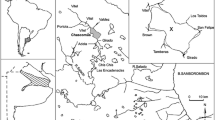Abstract
An unusual characteristic of the cosmopolitan haptophyte Phaeocystis globosa is its ability to form colonies of strikingly large size-up to 3 cm in diameter. The large size and the presence of a mucoid envelope are believed to contribute to the formation of dense blooms in Southeast Asia. We collected colonies of different sizes in shallow coastal waters of Viet Nam and conducted a series of measurements and experiments on individual colonies. Using these empirical data, we developed a simple carbon-based model to predict the growth and maximal size of P. globosa colonies. Our model suggests that growth of a colony from 0.2 cm to 1.4 cm (the maximal size in our samples) would take 16 days. This number, however, is strongly influenced by the maximal photosynthetic rate and other physiological parameters used in the model. The model also returns a specific growth rate of 0.30 d-1 for colonial cells, comparable to satellite estimates, but lower than have been measured for unicellular P. globosa in batch culture at similar temperatures. We attribute this low growth rate to not only the model uncertainties, but factors such as self-shading and diffusive limitation of nutrient uptake.
Similar content being viewed by others
References
Cadée G (1996) Accumulation and sedimentation of Phaeocystis globosa in the Dutch Wadden Sea. J Sea Res 36:321–327
Chen YQ, Wang N, Zhang P, Zhou H, Qu LH (2002) Molecular evidence identifies bloom-forming Phaeocystis (Prymnesiophyta) from coastal waters of southeast China as Phaeocystis globosa. Biochem Syst Ecol 30:36–46
Christian JR, Anderson TR (2002) Modeling DOM biogeochemistry. In: Hansell DA, Carlson CA (ed) Biogeochemistry of marine dissolved organic matter. Academic Press, Orlando, pp 717–756
Doan NH, Nguyen NL, Dippner JW (2010) Development of Phaeocystis globosa blooms in the upwelling waters of the south central coast of Viet Nam. J Mar Syst 83:253–261
Falkowski PG (1992) Molecular ecology of phytoplankton photosynthesis. In: Falkowski PG, Woodhead AD (eds) Primary productivity and biogeochemical cycles in the sea. Plenum Press, New York, pp 47–67
Flynn KJ, Stoecker DK, Mitra A, Raven JA, Glibert PM, Hansen PJ, Graneli E, Burkholder JM (2013) Misuse of the phytoplanktonzooplankton dichotomy: the need to assign organisms as mixotrophs within plankton functional types. J Plankton Res 35:3–11
Hamm C, Simson D, Merkel R, Smetacek V (1999) Colonies of Phaeocystis globosa are protected by a thin but tough skin. Mar Ecol-Prog Ser 187:101–111
Jakobsen HH, Tang KW (2002) Effects of protozoan grazing on colony formation in Phaeocystis globosa (Prymnesiophyceae) and the potential costs and benefits. Aquat Microb Ecol 27:261–273
Liu X (2011) Ecological, physiological and bio-optical characteristics of Phaeocystis globosa in coastal waters of south central Vietnam. M.S. Thesis, College of William and Mary, 142 p
Liss PS, Malin G, Turner SM, Holligan PM (1994) Dimethyl sulfide and Phaeocystis: a review. J Mar Syst 5:41–53
Madhupratap M, Sawant S, Gauns M (2000) A first report on a bloom of the marine prymnesiophycean, Phaeocystis globosa from the Arabian Sea. Oceanol Acta 23:83–90
Meinel AB, Meinel MP (1976) Applied solar energy: an introduction. Addison-Wesley, Reading, 650 p
Muscatine L, Falkowski PG, Porter JW, Dubinsky Z (1984) Fate of photosynthetic fixed carbon in light-and shade-adapted colonies of the symbiotic coral Stylophora pistillata. P Roy Soc Lond B 222:181–202
Nguyen NV, Tung LT, Hoa LX, Thoa NV, Thanh NC, Hoa VM (2012) Red tides in Halong Bay, Viet Nam caused serious loss in aquaculture. In: Proceedings of the international conference on Bien Dong 2012 (Abstract), Nha Trang, pp 146
Peperzak L, Colijn F, Vrieling EG, Gieskes WWC, Peeters JCH (2000) Observations of flagellates in colonies of Phaeocystis globosa (Prymnesiophyceae): a hypothesis for their position in the life cycle. J Plankton Res 22:2181–2203
Ploug H, Stolte W, Jorgensen BB (1999) Diffusive boundary layers of the colony-forming plankton alga Phaeocystis sp.: implications for nutrient uptake and cellular growth. Limnol Oceanogr 44:1959–1967
Qi YZ, Chen JF, Wang ZH, Xu N, Wang Y, Shen PP, Lu SH, Hodgkiss IJ (2004) Some observations on harmful algal bloom (HAB) events along the coast of Guangdong, southern China in 1998. Hydrobiologia 512:209–214
Rousseau V, Mathot S, Lancelot C (1990) Calculating carbon biomass of Phaeocystis sp. from microscopic observations. Mar Biol 107:305–314
Rousseau V, Chretiennot-Dinet M, Jacobsen A, Verity P, Whipple S (2007) The life cycle of Phaeocystis: state of knowledge and presumptive role in ecology. Biogeochemistry 83:29–47
Ruardij P, Veldhuis MJW, Brussaard CPD (2005) Modeling the bloom dynamics of the polymorphic phytoplankter Phaeocystis globosa: impact of grazers and viruses. Harmful Algae 4:941–963
Schoemann V, Becquevort S, Stefels J, Rousseau W, Lancelot C (2005) Phaeocystis blooms in the global ocean and their controlling mechanisms: A review. J Sea Res 53:43–66
Smith WO, Liu X, Tang KW, DeLizo LM, Doan NH, Nguyen NL, Wang X (2014) Giantism and its role in the harmful algal bloom species Phaeocystis globosa. Deep-Sea Res Pt II, 101:95–106
Stefels J, Dijkhuizen L, Gieskes WWC (1995) DMSP-lyase activity in a spring phytoplankton bloom off the Dutch coast, related to Phaeocystis sp. abundance. Mar Ecol-Prog Ser 123:235–243
van Rijssel M, Hamm CE, Gieskes WC (1997) Phaeocystis globosa (Prymnesiophyceae) colonies: hollow structures built with small amounts of polysaccharides. Eur J Phycol 32:185–192
Verity PG, Smayda TJ, Sakshaug E (1991) Photosynthesis, excretion, and growth rates of Phaeocystis colonies and solitary cells. Polar Res 10:117–128
Wang X, Wang Y, Smith WO Jr (2011) The role of nitrogen on the growth and colony development of Phaeocystis globosa (Prymnesiophyceae). Eur J Phycol 46:305–314
Wang Y, Smith WOJr, Wang X, Li S (2010) Subtle biological responses to increased CO2 concentrations by Phaeocystis globosa Scherffel, a harmful algal bloom species. Geophys Res Lett 37:L09604
Author information
Authors and Affiliations
Corresponding author
Rights and permissions
About this article
Cite this article
Liu, X., Smith, W.O., Tang, K.W. et al. Theoretical size controls of the giant Phaeocystis globosa colonies. Ocean Sci. J. 50, 283–289 (2015). https://doi.org/10.1007/s12601-015-0025-1
Received:
Revised:
Accepted:
Published:
Issue Date:
DOI: https://doi.org/10.1007/s12601-015-0025-1




